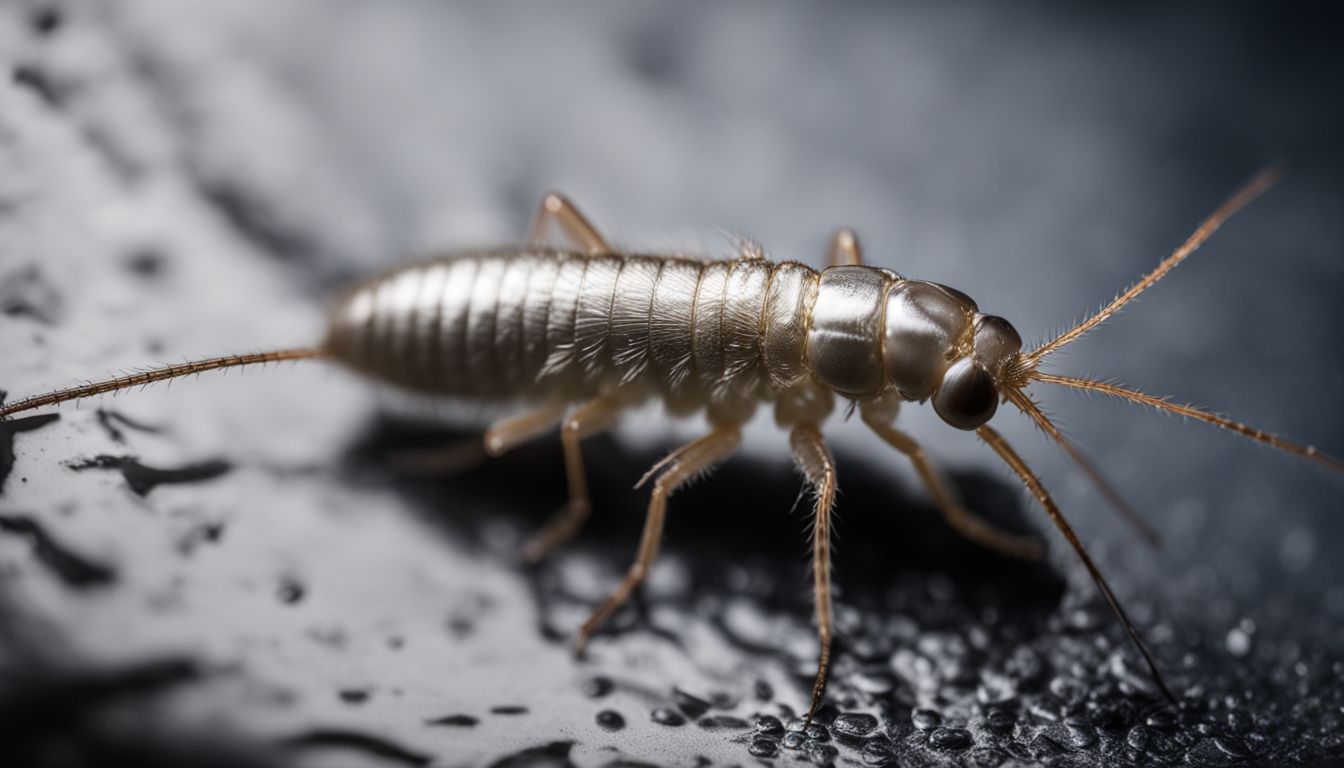“This post contains affiliate links. As an Amazon Associate, I earn from qualifying purchases”
Have you ever spotted a small, silvery critter zipping across your bathroom floor or lurking in your pantry? Silverfish are common houseguests, but their presence can be more than just an annoyance.
These elusive insects not only feast on your cereals and starches but also carry the remarkable ability to cling onto almost any surface with ease. It’s this gluey talent that makes them both fascinating and frustratingly hard to manage.
Did you know silverfish have specialized sticky pads on their legs? Yes, these tiny structures let them scale walls and dash into crevices — evading capture like miniature superheroes! In our upcoming blog post, we’ll reveal how understanding these creatures’ extraordinary adhesive skills can aid in keeping them out of your living spaces for good.
Get ready to peel back the layers of mystery surrounding these slippery guests with practical solutions at hand.
Stay tuned — it’s going to get sticky!
Unpacking The Gluey Secrets of Silverfish

Dive deep into the mysterious world of silverfish — these elusive critters have more up their sleeves than just a quick scuttle. Let’s peel back the layers on how their sticky strategies are key to survival and reproduction in our very own homes.
Silverfish behavior of sticking onto surfaces for protection
Silverfish have a special trick to keep safe. They use sticky pads on their legs that let them hold tight to walls and ceilings. This skill helps them hide from things that want to eat them, like spiders or birds.
When they feel scared, silverfish run fast and press onto flat places where it’s hard for predators to grab them.
These crafty bugs make the most of their glue-like feet not just to stay out of trouble but also to build homes and lay eggs. It’s pretty smart – they stick close together in cracks and corners where it’s dark and damp; perfect spots for silverfish families.
Next up, we’ll talk about why it’s important to stop these pests from moving into your space.
The use of their gluey secretions for building nests and laying eggs
So, these clever little critters not only stick to surfaces but they also make their homes using the same sticky stuff. Silverfish have a special glue that comes in handy for more than just hiding away.
They use this substance to put together safe spots for their eggs, tucking them into tiny cracks or under objects where predators can’t easily find them. The nests are strong because of the glue and provide a hidden place for baby silverfish to grow up.
This sticky trick is key for silverfish families. It makes sure their eggs stay put and gives the young ones a fighting chance when they hatch. By building durable nests with their secretions, silverfish protect their little ones from harm and give them cozy places to call home until they’re ready to venture out on their own.
This is smart pest management at its most basic – keeping future generations safe with what nature provides.
The importance of understanding and controlling silverfish infestations
Silverfish are sneaky little bugs that can slip into your home through tiny cracks and crevices. Once inside, they munch on your books, clothes, and wallpaper. They’re not just creepy crawlers – they can actually ruin important stuff you own.
That’s why getting to know how these pests behave is super key in stopping them from settling in. You’ve got to keep an eye out for the sticky trails they leave or the nests where they lay eggs.
Getting rid of silverfish means making sure they don’t have what they need to survive – like food from starchy snacks or damp spots in bathrooms. Lock up those cereal boxes tight and fix that leaky pipe! Sealing off their secret passageways keeps these critters out for good.
If you take care of these things, then pest control services won’t be needed as often – saving you time and money! Let’s dive now into how we can prevent silverfish from taking over our homes.
How to Prevent and Get Rid of Silverfish

Navigating the slippery slope of silverfish prevention requires a blend of diligence and savvy; let’s delve into practical strategies that safeguard your home from these persistent pests.
Understandably, you won’t find any tired tips or repackaged pointers here—only fresh, actionable insights to help turn your space into a no-glue zone for these crafty critters.
Removing food sources and moisture
Silverfish love damp spots and munching on starchy food. To keep them away, it’s smart to dry out your home. Use dehumidifiers and make sure places like basements get plenty of air.
This cuts down the moisture that these pests find so cozy.
Also, tidy up any bits of food lying around. Put things like cereal, pasta, and sugar in tight-sealed containers. Don’t leave books or cardboard boxes piled up because silverfish can’t resist them either! By doing this, you’ll have fewer unwanted guests scuttling around your space.
Sealing entry points and using traps
Cutting off food and water sources is smart, but don’t stop there. It’s just as important to shut any tiny openings silverfish might use to sneak into your home. Look around for cracks or holes in walls, windows, and floors.
Seal these spots with caulk to keep the pesky bugs out.
Traps are another great tool for catching silverfish. Sticky traps work well—place them in areas where you’ve seen the insects hanging out. You can also make a trap using a glass jar coated inside with something sticky like tape; add a mix of sugar and water as bait at the bottom.
Silverfish will climb in for the sweet treat and get stuck! By sealing up entry points and setting traps, you’ll be on your way to a silverfish-free space.
Using natural repellents and professional pest control services
Once you’ve sealed the cracks and set traps, it’s time to keep silverfish away for good. Natural repellents can make your home smell great while driving pests out. Cedar oil is a top choice — its strong scent is something silverfish hate.
Spritzing citrus sprays around your home can also send these bugs packing.
Sometimes, though, you need an expert touch. That’s where professional pest-control teams come in. They use powerful tools and know-how to get rid of silverfish fast. With their help, you won’t have to worry about these pesky insects sticking around or causing allergic reactions with their shed skin and droppings.
Conclusion
Silverfish are super clingy creatures, and now we know why. Their sticky feet let them run up walls to stay safe. If you see these bugs at home, keep it dry, clean up food bits, and block where they get in.
They may be small, but their world of glue is a big deal for science and keeping houses bug-free!
FAQs
1. What are silverfish, and why should we control them?
Silverfish – you know, those little, quick bugs that love damp places? They’re called Lepisma saccharina or urban silverfish and can trigger allergic symptoms in some folks. So, to keep things comfy at home, keeping these pests away is a good idea.
2. Can silverfish cause allergies like other common household pests?
Ah yes! Silverfish can stir up allergens just by being around – much like dust mites or bed bugs. If you notice itching or sneezing without a clear reason… might be worth checking for these shiny guests!
3. What’s the best way to get rid of silverfish?
Diatomaceous earth is one smart move – sprinkle it where they hang out, and it’s bye-bye bugs! Plus, don’t forget moisture control; keeping things dry makes your home less inviting to them.
4. Are there any natural methods for dealing with a silverfly infestation?
Absolutely — integrated pest management (IPM) comes into play here. It’s about using multiple strategies: termite control isn’t just about killing bugs; think humidity checks and pest deterrents too.
5. How does professional extermination differ from DIY methods when tackling silverfish problems?
Professionals like Orkin bring in heavy-duty tactics — think rodent control meets insect warzone… but tailored! They assess the situation then pick the right tools—deodorizers could fly out while serious extermination gear steps in.